.
Theophilos Hatzimihail (Θεόφιλος Χατζημιχαήλ or Θεόφιλος Κεφαλάς; ca. 1870, Vareia, near Mytilene, island of Lesbos, Greece – Vareia, 22 March, 1934), known simply as Theophilos, was a major folk painter of Neo-Hellenic art. The main subject of his works are Greek characters and the illustration of Greek traditional folklife and history.



Sappho , Dance of Evzonoi and villagers in Megara, Zalongos Dance ,
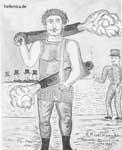
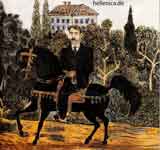
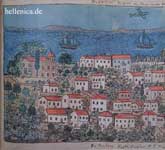

Panagis Koutalianos, Giannis Kontos, Seaside village of Mytilene, Villager from Mytilini,
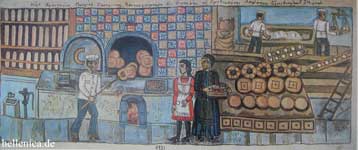
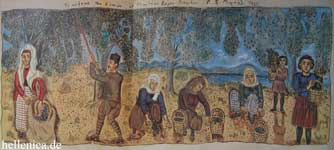
Baker's shop, Olive harvest , Mytilini ,
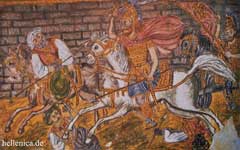
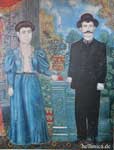


Konstantinos Palaiologos, Married couple from Pilion, Leonidas Androutsos, Athanasios Diakos,


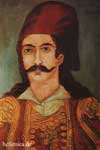
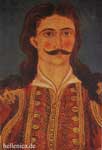
Erotokritos and Aretousa, Palaion Patron Germanos, Markos Botsaris, Athanasios Diakos,
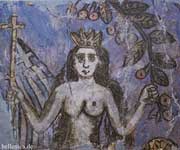

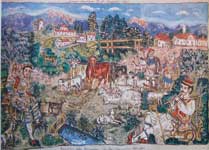
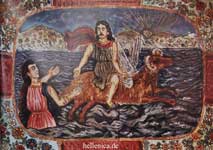
Gorgona, Kechagias, Shepherds of Cheimara, Phrixus on the golden ram ,
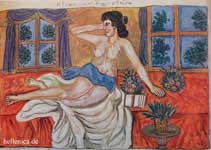
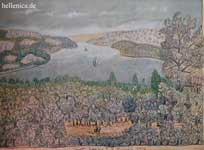

Despair, Gulf of Geras, Cropping in Molyvos,
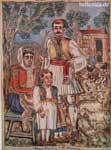
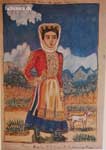



Shepherd from Messolonghi, Countrywoman from Corfu, Countryside barbers, Greek dancer, Dancing bear,
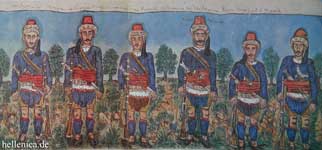
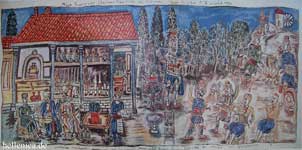
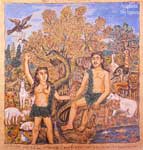
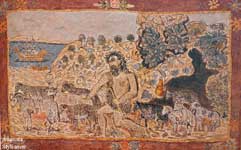


Biography
The exact birthdate of Theophilos is unknown. However, it is believed that he was born between 1867 and 1870 in Vareia (Βαρειά), a village outside of Mytilene (then part of the Ottoman Empire). His father, Gabriil Kefalas, was a shoemaker, while his mother Pinelopi Hatzimihail was a daughter of an iconographer. When he was very young he was mediocre at school, but he had a special interest in painting, having learned the basics from his grandfather.
His life was very hard in part because people made fun of him, since he went around wearing the traditional Greek kilt, the fustanella. At the age of 18 he abandoned his home and family and worked as a gate-keeper (καβάσης, kavasis) at the Greek consulate in Smyrna. There he stayed a few years, before he settled in the city of Volos in about 1897, searching for occasional work and painting in houses and shops of the area. Many of his murals exist today. Most of his years he spent in Pelion. His protector during that period was the landholder Giannis Kontos, for whom he did many works. Today the house of Kontos is the Theophilos Museum. As well as painting, he was also involved in organizing popular theatrical acts for national ceremonies, and in the carnival period he had a major role, sometimes dressing as Alexander the Great, with pupils in macedonian phalanx formation, and sometimes as a hero of the Greek Revolution, with gear and costumes made by himself.
In 1927 he returned to Mytilene. Legend states that he left Volos because of an incident in a kafeneio (coffee shop), when someone played a joke on him in front of others and threw him down from a ladder where he was painting.
In Mytilene, despite the mockery of the people, he continued to draw, painting many murals in villages for little payment, usually for a plate of food and a cup of wine.[1] Many of his works of this period have been lost, either due to natural aging or from damage by the owners.
In Mytilene, the renowned art critic and publisher Stratis Eletheriadis (Tériade), who lived in Paris, discovered Theophilos and brought him a great deal of recognition and also international publicity, though posthumous. With Tériade's funding in 1964 the Museum of Theophilos was constructed in Vareia, Lesbos.
Theophilos died in March 1934, on the eve of the Annunciation, perhaps from food poisoning. One year later, his works were exhibited in the Louvre as a sample of a genuine folk painter of Greece.
Bibliography
Yannis Tsarouchis, Theophilos (Athens: The Commercial Bank of Greece, 1966).
Odysseas Elytis, The Painter Theophilos, pub. Ypsilon, Athens 1996. ISBN 960-17-0011-0.
Kitsos Makris, The Painter Theophilos at Pilios, 3rd Edition, εκδ. Δημοτικού Κέντρου Ιστορικών Ερευνών, Αρχείων και Εκθεμάτων Βόλου, Volos 1998. ISBN 960-85703-1-X.
Ε. Παπαζαχαρίου, Ο άλλος Θεόφιλος, εκδ. Κάκτος, Αθήνα 1997.
Ντ. Παπασπύρου, Θεόφιλος Γ.Χ. Μιχαήλ, εκδ. Ιανός, Θεσσαλονίκη 1998. ISBN 960-7771-16-8.
Greeks:
A - B - C - D - E - F - G - H - I - J - K - L - M -
N - O - P - Q - R - S - T - U - V - W - X - Y - Z
Artist
A - B - C - D - E - F - G - H - I - J - K - L - M -
N - O - P - Q - R - S - T - U - V - W - X - Y - Z
| Ancient Greece
Science, Technology , Medicine , Warfare, , Biographies , Life , Cities/Places/Maps , Arts , Literature , Philosophy ,Olympics, Mythology , History , Images Medieval Greece / Byzantine Empire Science, Technology, Arts, , Warfare , Literature, Biographies, Icons, History Modern Greece Cities, Islands, Regions, Fauna/Flora ,Biographies , History , Warfare, Science/Technology, Literature, Music , Arts , Film/Actors , Sport , Fashion --- |
From Wikipedia, All text is available under the terms of the GNU Free Documentation License

